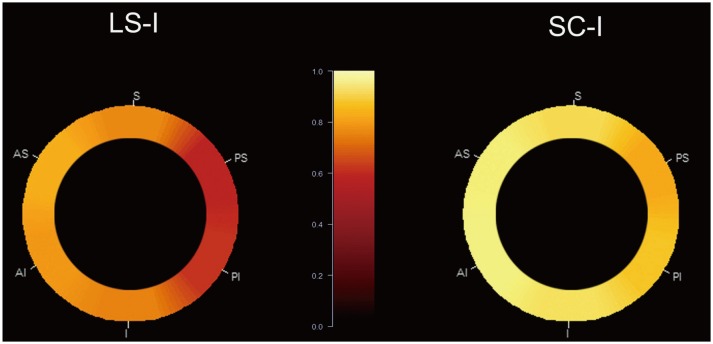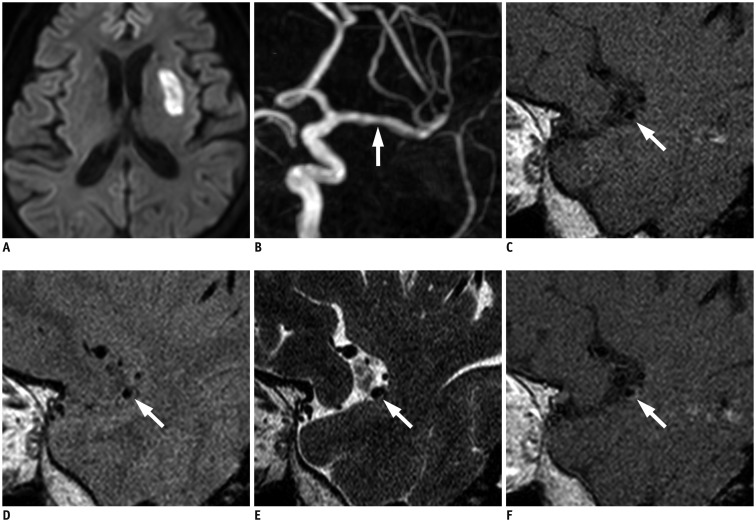Korean J Radiol.
2017 Dec;18(6):964-972. 10.3348/kjr.2017.18.6.964.
Differentiation of Deep Subcortical Infarction Using High-Resolution Vessel Wall MR Imaging of Middle Cerebral Artery
- Affiliations
-
- 1Department of Radiology, Seoul National University College of Medicine, Seoul National University Bundang Hospital, Seongnam 13620, Korea. byungse.choi@gmail.com
- 2Department of Neurology, Seoul National University College of Medicine, Seoul National University Bundang Hospital, Seongnam 13620, Korea.
- KMID: 2427206
- DOI: http://doi.org/10.3348/kjr.2017.18.6.964
Abstract
OBJECTIVE
To evaluate the utility of high-resolution vessel wall imaging (HR-VWI) of middle cerebral artery (MCA), and to compare HR-VWI findings between striatocapsular infarction (SC-I) and lenticulostriate infarction (LS-I).
MATERIALS AND METHODS
This retrospective study was approved by the Institutional Review Board, and informed consent was waived. From July 2009 to February 2012, 145 consecutive patients with deep subcortical infarctions (SC-I, n = 81; LS-I, n = 64) who underwent HR-VWI were included in this study. The degree of MCA stenosis and the characteristics of MCA plaque (presence, eccentricity, location, extent, T2-high signal intensity [T2-HSI], and plaque enhancement) were analyzed, and compared between SC-I and LS-I, using Fisher's exact test.
RESULTS
Stenosis was more severe in SC-I than in LS-I (p = 0.040). MCA plaque was more frequent in SC-I than in LS-I (p = 0.028), having larger plaque extent (p = 0.001), more T2-HSI (p = 0.001), and more plaque enhancement (p = 0.002). The eccentricity and location of the plaque showed no significant difference between the two groups.
CONCLUSION
Both SC-I and LS-I have similar HR-VWI findings of the MCA plaque, but SC-I had more frequent, larger plaques with greater T2-HSI and enhancement. This suggests that HR-VWI may have a promising role in assisting the differentiation of underlying pathophysiological mechanism between SC-I and LS-I.
Keyword
MeSH Terms
-
Acute Disease
Adult
Aged
Aged, 80 and over
Cerebral Infarction/*diagnosis/diagnostic imaging/pathology
Chronic Disease
Constriction, Pathologic
Female
Humans
Image Processing, Computer-Assisted
*Magnetic Resonance Angiography
Male
Middle Aged
Middle Cerebral Artery/*diagnostic imaging/physiopathology
Plaque, Atherosclerotic
Retrospective Studies
Figure
Cited by 1 articles
-
Age of Data in Contemporary Research Articles Published in Representative General Radiology Journals
Ji Hun Kang, Dong Hwan Kim, Seong Ho Park, Jung Hwan Baek
Korean J Radiol. 2018;19(6):1172-1178. doi: 10.3348/kjr.2018.19.6.1172.
Reference
-
1. Jung S, Hwang SH, Kwon SB, Yu KH, Lee BC. The clinico-radiologic properties of deep small basal ganglia infarction: lacune or small striatocapsular infarction? J Neurol Sci. 2005; 238:47–52. PMID: 16126229.
Article2. Boiten J, Lodder J. Large striatocapsular infarcts: clinical presentation and pathogenesis in comparison with lacunar and cortical infarcts. Acta Neurol Scand. 1992; 86:298–303. PMID: 1414250.
Article4. Donnan GA, Bladin PF, Berkovic SF, Longley WA, Saling MM. The stroke syndrome of striatocapsular infarction. Brain. 1991; 114(Pt 1A):51–70. PMID: 1998890.5. Nah HW, Kang DW, Kwon SU, Kim JS. Diversity of single small subcortical infarctions according to infarct location and parent artery disease: analysis of indicators for small vessel disease and atherosclerosis. Stroke. 2010; 41:2822–2827. PMID: 20966406.6. Bogousslavsky J. The plurality of subcortical infarction. Stroke. 1992; 23:629–631. PMID: 1579957.
Article7. Levine RL, Lagreze HL, Dobkin JA, Turski PA. Large subcortical hemispheric infarctions. Presentation and prognosis. Arch Neurol. 1988; 45:1074–1107. PMID: 3052374.8. Caplan LR. Intracranial large artery occlusive disease. Curr Neurol Neurosci Rep. 2008; 8:177–181. PMID: 18541112.
Article9. Fisher CM. Capsular infarcts: the underlying vascular lesions. Arch Neurol. 1979; 36:65–73. PMID: 420625.10. Lhermitte F, Gautier JC, Derouesné C. Nature of occlusions of the middle cerebral artery. Neurology. 1970; 20:82–88. PMID: 5460773.
Article11. Zhao DL, Deng G, Xie B, Ju S, Yang M, Chen XH, et al. High-resolution MRI of the vessel wall in patients with symptomatic atherosclerotic stenosis of the middle cerebral artery. J Clin Neurosci. 2015; 22:700–704. PMID: 25744074.
Article12. Xu WH, Li ML, Gao S, Ni J, Yao M, Zhou LX, et al. Middle cerebral artery intraplaque hemorrhage: prevalence and clinical relevance. Ann Neurol. 2012; 71:195–198. PMID: 22367991.
Article13. Xu WH, Li ML, Gao S, Ni J, Zhou LX, Yao M, et al. Plaque distribution of stenotic middle cerebral artery and its clinical relevance. Stroke. 2011; 42:2957–2959. PMID: 21799160.
Article14. Kim JM, Jung KH, Sohn CH, Moon J, Han MH, Roh JK. Middle cerebral artery plaque and prediction of the infarction pattern. Arch Neurol. 2012; 69:1470–1475. PMID: 22910889.
Article15. Niizuma K, Shimizu H, Takada S, Tominaga T. Middle cerebral artery plaque imaging using 3-Tesla high-resolution MRI. J Clin Neurosci. 2008; 15:1137–1141. PMID: 18703337.
Article16. Ryoo S, Lee MJ, Cha J, Jeon P, Bang OY. Differential vascular pathophysiologic types of intracranial atherosclerotic stroke: a high-resolution wall magnetic resonance imaging study. Stroke. 2015; 46:2815–2821. PMID: 26330443.
Article17. Bodle JD, Feldmann E, Swartz RH, Rumboldt Z, Brown T, Turan TN. High-resolution magnetic resonance imaging: an emerging tool for evaluating intracranial arterial disease. Stroke. 2013; 44:287–292. PMID: 23204050.18. Li ML, Xu WH, Song L, Feng F, You H, Ni J, et al. Atherosclerosis of middle cerebral artery: evaluation with high-resolution MR imaging at 3T. Atherosclerosis. 2009; 204:447–452. PMID: 19041971.
Article19. Klein IF, Lavallée PC, Schouman-Claeys E, Amarenco P. High-resolution MRI identifies basilar artery plaques in paramedian pontine infarct. Neurology. 2005; 64:551–552. PMID: 15699395.
Article20. Chung JW, Kim BJ, Sohn CH, Yoon BW, Lee SH. Branch atheromatous plaque: a major cause of lacunar infarction (high-resolution MRI study). Cerebrovasc Dis Extra. 2012; 2:36–44. PMID: 23060895.
Article21. van Everdingen KJ, van der Grond J, Kappelle LJ, Ramos LM, Mali WP. Diffusion-weighted magnetic resonance imaging in acute stroke. Stroke. 1998; 29:1783–1790. PMID: 9731595.
Article22. Zou XD, Chung YC, Zhang L, Han Y, Yang Q, Jia J. Middle cerebral artery atherosclerotic plaques in recent small subcortical infarction: a three-dimensional high-resolution MR study. Biomed Res Int. 2015; 2015:540217. PMID: 26539508.
Article23. Chung GH, Kwak HS, Hwang SB, Jin GY. High resolution MR imaging in patients with symptomatic middle cerebral artery stenosis. Eur J Radiol. 2012; 81:4069–4074. PMID: 22846476.
Article24. Skarpathiotakis M, Mandell DM, Swartz RH, Tomlinson G, Mikulis DJ. Intracranial atherosclerotic plaque enhancement in patients with ischemic stroke. AJNR Am J Neuroradiol. 2013; 34:299–304. PMID: 22859280.
Article25. Vergouwen MD, Silver FL, Mandell DM, Mikulis DJ, Swartz RH. Eccentric narrowing and enhancement of symptomatic middle cerebral artery stenoses in patients with recent ischemic stroke. Arch Neurol. 2011; 68:338–342. PMID: 21403018.
Article26. Yoon Y, Lee DH, Kang DW, Kwon SU, Kim JS. Single subcortical infarction and atherosclerotic plaques in the middle cerebral artery: high-resolution magnetic resonance imaging findings. Stroke. 2013; 44:2462–2467. PMID: 23847248.27. Bladin PF, Berkovic SF. Striatocapsular infarction: large infarcts in the lenticulostriate arterial territory. Neurology. 1984; 34:1423–1430. PMID: 6493490.
Article28. Croisille P, Turjman F, Croisile B, Tournut P, Laharotte JC, Aimard G, et al. Striatocapsular infarction: MRI and MR angiography. Neuroradiology. 1994; 36:430–431. PMID: 7991084.
Article29. Glagov S, Weisenberg E, Zarins CK, Stankunavicius R, Kolettis GJ. Compensatory enlargement of human atherosclerotic coronary arteries. N Engl J Med. 1987; 316:1371–1375. PMID: 3574413.
Article30. Thrysøe SA, Oikawa M, Yuan C, Eldrup N, Klaerke A, Paaske WP, et al. Longitudinal distribution of mechanical stresses in carotid plaques of symptomatic patients. Stroke. 2010; 41:1041–1043. PMID: 20224059.
Article31. Toutouzas K, Karanasos A, Tsiamis E, Riga M, Drakopoulou M, Synetos A, et al. New insights by optical coherence tomography into the differences and similarities of culprit ruptured plaque morphology in non-ST-elevation myocardial infarction and ST-elevation myocardial infarction. Am Heart J. 2011; 161:1192–1199. PMID: 21641368.
Article32. Shindo S, Fujii K, Shirakawa M, Uchida K, Enomoto Y, Iwama T, et al. Morphologic features of carotid plaque rupture assessed by optical coherence tomography. AJNR Am J Neuroradiol. 2015; 36:2140–2146. PMID: 26272975.
Article33. Kang CK, Park CW, Han JY, Kim SH, Park CA, Kim KN, et al. Imaging and analysis of lenticulostriate arteries using 7.0-Tesla magnetic resonance angiography. Magn Reson Med. 2009; 61:136–144. PMID: 19097221.
Article34. Liem MK, van der Grond J, Versluis MJ, Haan J, Webb AG, Ferrari MD, et al. Lenticulostriate arterial lumina are normal in cerebral autosomal-dominant arteriopathy with subcortical infarcts and leukoencephalopathy: a high-field in vivo MRI study. Stroke. 2010; 41:2812–2816. PMID: 20966419.
- Full Text Links
- Actions
-
Cited
- CITED
-
- Close
- Share
- Similar articles
-
- Cerebral Infarction Secondary to Vascular Infiltration of Glioblastoma Confirmed in High-Resolution Vessel Wall MRI
- Roles of Diagnostic Cerebral Angiography and High-resolution Vessel-wall Imaging in Evaluating Basilar Artery Perforators: A Case of Bilateral Midbrain Infarction
- Clinical and Radiologic Features of Symptomatic Single Small Deep Cerebral Infarction
- Progressive Middle Cerebral Artery Infarction in a Patient with Thrombotic Thrombocytopenic Purpura
- Childhood Primary Angiitis of the Central Nervous System Presenting as Isolated Middle Cerebral Artery Dissection



